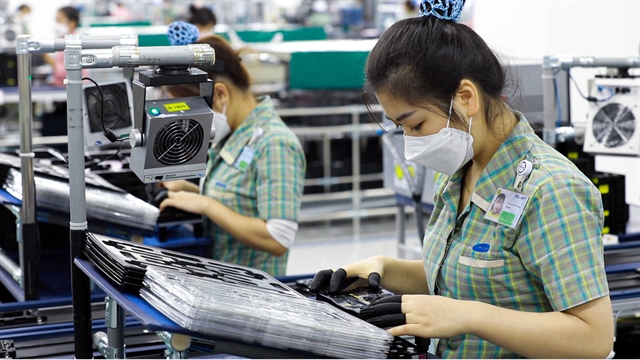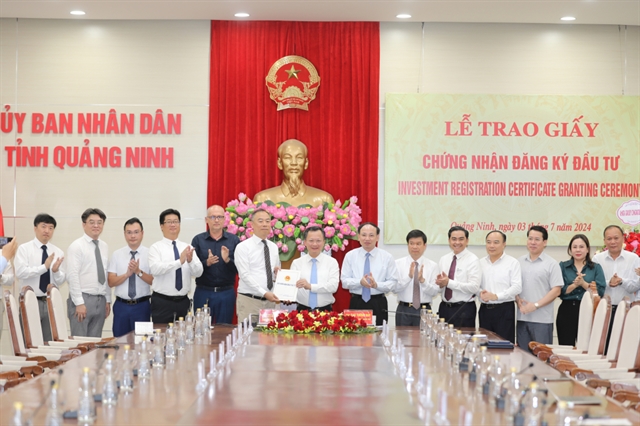 |
| An assembly line at Samsung Electronics Việt Nam Thái Nguyên. Samsung has long regarded Việt Nam as a global manufacturing hub, having invested over $22.4 billion. Photo courtesy of Samsung Việt Nam |
Mai Hương
Việt Nam has a prime opportunity to lead in attracting technological “eagles”.
Earlier this month, Foxconn Group received the green light from the Quảng Ninh provincial government to launch two projects worth US$551 million in the province. These projects, aimed at producing smart entertainment products and smart systems, fall within Quảng Ninh’s target industries for investment in processing and manufacturing.
With these initiatives, Foxconn’s total investment in Quảng Ninh rises to nearly $1 billion and surpasses $3 billion in Việt Nam overall. The company is involved in large-scale electronics and components projects in Bắc Giang and Bắc Ninh provinces, including the manufacturing of equipment and components for Apple. Last month, Foxconn also invested $383 million in a project at the Nam Sơn Hạp Lĩnh Industrial Park in Bắc Ninh.
 |
| Cao Tường Huy, deputy secretary of the Provincial Party Committee, chairman of Quảng Ninh People’s Committee, awarded the investment registration certificate to Foxconn Group. Photo baoquangninh.vn |
Meanwhile, the Amkor Group recently obtained an amended investment certificate to boost its investment by an additional $1.07 billion for its semiconductor project in Bắc Ninh. This decision has propelled the total investment in the Amkor project to $1.6 billion, a staggering 11 years ahead of schedule. Initially, Amkor had projected to invest only $1.6 billion in Việt Nam by 2035.
In addition to these two investors, recent reports indicate that numerous prominent technology corporations like Samsung, LG, and industry giants such as Hyosung, CJ, and Posco are gearing up to inject billions more into Việt Nam in the near future.
During a recent meeting with Prime Minister Phạm Minh Chính during his official visit to South Korea, Jeong Cheol-dong, CEO of LG Display, said LG had already poured over $5 billion into investments in Việt Nam and planned to invest an extra $3 billion over the next five years. As part of this expansion, the LG Innotel factory aimed to double its capacity, solidifying LG’s integrated production hub in Việt Nam. Jeong added that LG viewed Việt Nam as its critical manufacturing hub.
Meanwhile, Samsung has long regarded Việt Nam as a global manufacturing hub, having invested over $22.4 billion and consistently increasing its capital in recent years by an average of around $1 billion annually. With the opening of its Research and Development (R&D) Centre in late 2022, Samsung has designated Việt Nam as the group’s global R&D hub – a designation that Việt Nam had never anticipated.
This, however, is just the beginning, as Việt Nam is increasingly becoming a focal point for global corporations in the semiconductor and AI sectors. Companies like Intel, Amkor, HanaMicron, Marvell, and Synopsys have already invested in Việt Nam and continue to do so.
Meanwhile, NVIDIA Corporation is progressively actualising its vision of making Việt Nam its “second home”.
Minister of Planning and Investment (MPI) Nguyễn Chí Dũng recently engaged in an online discussion with NVIDIA to explore further collaboration plans.
The interest of tech giants in Việt Nam is palpable. In a recent statement, the MPI highlighted that not only would numerous large-scale projects spanning semiconductors, energy (including battery production, photovoltaic cells, and silicon bars), component manufacturing, electronics, and high-value-added products see fresh investments and expanded capital in the first half of this year, but Việt Nam also held promise in attracting investments across cutting-edge industries like AI, semiconductors, hydrogen, and renewable energy.
The MPI is currently finalising a Draft Decree concerning the establishment, management, and utilisation of the Investment Support Fund. This initiative aims to provide support from the Government to high-tech enterprises, companies engaged in producing high-tech goods, and those undertaking high-tech application projects.
According to Statista Market Insights, Việt Nam is poised to experience a Compound Annual Growth Rate of 11.6 per cent in semiconductor revenue from 2023 to 2027, reaching $31.28 billion by 2027. Within this projection, integrated circuits, the cornerstone of the semiconductor industry, are anticipated to hit $16.44 billion this year.
Google’s forecast suggests that Việt Nam’s digital economy is set to surge eleven-fold by 2030, reaching $220 billion, nearly half of the country’s current GDP. AI will play a pivotal role in Việt Nam’s realisation of these forecasts, according to Marc Woo, managing director of Google Asia Pacific for Việt Nam.
The forecast appears clearly optimistic. However, given the intensifying competition for investment attraction, Việt Nam must act swiftly in the present landscape; otherwise, it would miss out on this unparalleled opportunity.
In a recent report to the Government, Minister Dũng of the MPI highlighted the persisting challenges facing the economy, noting that emerging sectors like the digital economy, green economy, AI, chips, and semiconductors are lagging, risking Việt Nam’s competitiveness on a global and regional scale.
The MPI reported that despite a steady rise in foreign investment in Việt Nam, the number of large-scale projects with advanced technology remained limited. Việt Nam has attracted only 108 projects exceeding $500 million in investment, averaging 15 projects annually, with a mere 27 falling within the high-tech sector.
“Immediate steps are required to cultivate skilled human resources, particularly in semiconductor electronics to sustain and enhance investment appeal. Simultaneously, addressing local electricity shortages in regions housing numerous electronics industry ventures is imperative. Additionally, streamlining processes to simplify and expedite post-investment registration procedures, such as obtaining construction permits and fire safety certifications, is crucial,” Dũng said.
However, this is just one of the challenges. The pressure to compete for foreign investment in the high-tech sector is intensifying, with many countries, including the US, Europe, South Korea, Japan, Malaysia, Indonesia, and Thailand, requiring substantial investment support policies.
South Korea, for instance, has unveiled a 26 trillion won (approximately $19 billion) support initiative to bolster the chip industry. Malaysia issued the New Industrial Master Plan 2030 by the end of 2023, with an estimated scale of around $20 billion, aimed at revitalising Malaysia’s industries, particularly in electronics, chemicals, electric vehicles, aerospace, pharmaceuticals, medical equipment, and advanced materials. China has established a $27 billion semiconductor investment fund to enhance the self-sufficiency of its semiconductor industry. The US and Europe are prepared to allocate tens of billions of dollars to support investors in the semiconductor sector.
The increasing pressure asks Việt Nam to ready its human resources, infrastructure, and other key elements while implementing globally competitive investment support policies to both retain current investors and entice more industry leaders.
During recent discussions, multinational corporations have shown interest in contributing to Việt Nam’s Investment Support Fund. The MPI is completing the Draft Decree on the establishment, governance, and utilisation of this fund. This initiative is designed to extend governmental support, including financial assistance, to high-tech enterprises; firms engaged in high-tech product manufacturing; those undertaking high-tech application projects; and companies investing in R&D centres, provided they meet specific criteria.
If this proposal is approved, it could serve as a catalyst for Việt Nam to attract additional tech powerhouses and solidify its status as a hub for cutting-edge industries.
Efforts made to help firms join global semiconductor supply chainThe MPI has taken various solutions to support domestic firms to join the global semiconductor supply chain more intensively.Bùi Anh Tuấn, chief of the Office of the MPI, said in a recent meeting that the ministry had also given consultancy to competent agencies to perfect relevant policies and laws to facilitate investment, while enhancing international cooperation in this field. It has coordinated with other ministries and agencies in drafting a project on human resources development in service of the semiconductor industry by 2030 with a vision towards 2050, which was submitted to Prime Minister Phạm Minh Chính for approval, and proposing the establishment of a national steering committee for the development of the sector.Minister Dũng pointed out difficulties facing other sectors in Việt Nam, such as retail, housing, and real estate, along with major tasks set for the remaining months of this year. He stressed the need to effectively put in place newly issued policies and regulations, and roll out breakthrough solutions to spur growth, asking agencies to join hands in building socioeconomic plans, orientations, tasks and solutions for 2025.The minister also urged preparations for the all-level Party congresses, towards the 14th National Party Congress, as well as reforms, breakthroughs and innovation in development during the 2026-30 period. VNS
- Reduce Hair Loss with PURA D’OR Gold Label Shampoo
- Castor Oil Has Made a “Huge” Difference With Hair and Brow Growth
- Excessive hair loss in men: Signs of illness that cannot be subjective
- Dịch Vụ SEO Website ở Los Angeles, CA: đưa trang web doanh nghiệp bạn lên top Google
- Nails Salon Sierra Madre
 VnExpress News The News Gateway of Vietnam
VnExpress News The News Gateway of Vietnam




